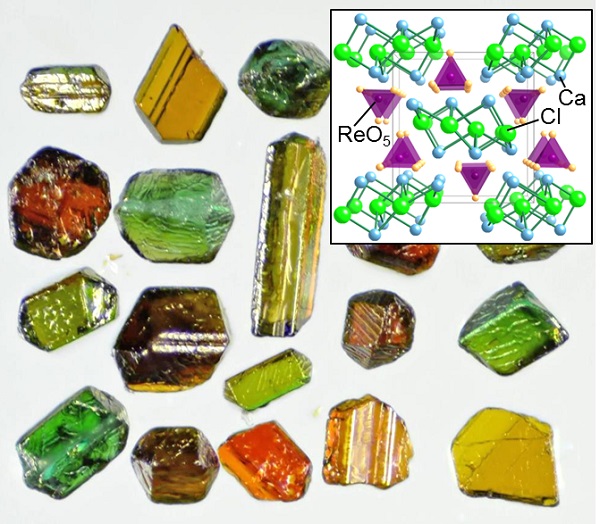Viewing direction, light polarization give different color to new compound Material containing heavy transition metal paves way for new functions


Photograph of single crystals and crystal structure of the new compound discovered in this study
The new compound Ca3ReO5Cl2 possesses a unique optical property called pleochroism, by which a material exhibits different colors depending on the viewing direction or the polarization of light. A couple characteristics play important roles in the manifestation of this property in the compound: the presence of 5d electrons in rhenium (Re) and the slightly distorted square pyramidal coordination of rhenium surrounded by five oxygen atoms (inset).
© 2017 Daigorou Hirai.
University of Tokyo researchers have successfully synthesized a new compound containing heavy transition metal element rhenium. The material's color changes from green to orange depending on the direction from which it is viewed and exhibits three different colors—green, red, and yellow—according to the polarization of the light striking its surface. The study's findings hold promise of providing a guideline for the development of materials possessing similar optical properties with the propensity to change colors.
The manifestation of colors by this compound is related to the light that is absorbed when the d electrons of the rhenium contained in the material are excited and reach a state of higher energy. Through the optical measurements and theoretical calculations it obtained, the research group led by Research Associate Daigorou Hirai and Professor Zenji Hiroi at the Institute for Solid State Physics, the University of Tokyo, revealed that the color change is a consequence of the energy—that is, the color in the light spectrum—that is absorbed, which is dependent on the polarization of the light. Moreover, the scientists found that the existence of 5d electrons in rhenium and the presence of two kinds of negatively charged ions, oxide and chloride ions, around the rhenium ion are instrumental in giving rise to this property. The discovery of this unique optical property demonstrates that 5d electrons could possess new material functions.
"This material was produced by accident when I was trying to synthesize other compounds. At first, I thought I had created separate compounds possessing different colors, but when I rotated a piece of the crystal with a pair of tweezers and realized that it changed colors according to the viewing direction, I was as excited as I have ever been in my life as a researcher," says Hirai. He continues, "The heavy transition metal element contained in this material plays an important role in displaying the optical properties. Investigation of functions in heavy transition metal compounds is still developing. I hope to synthesize new compounds containing heavy transition metal elements and discover new properties and functionalities."
Press release (Japanese)
Paper
, "'Visible' 5d orbital states in a pleochroic oxychloride", Journal of the American Chemical Society Online Edition: 2017/07/17 (Japan time), doi: 10.1021/jacs.7b05128.
Article link (Publication)
Links
Institute for Solid State Physics
Graduate School of Frontier Sciences
Department of Advanced Materials Science, Graduate School of Frontier Sciences
Hiroi Lab, Institute for Solid State Physics (Japanese)






